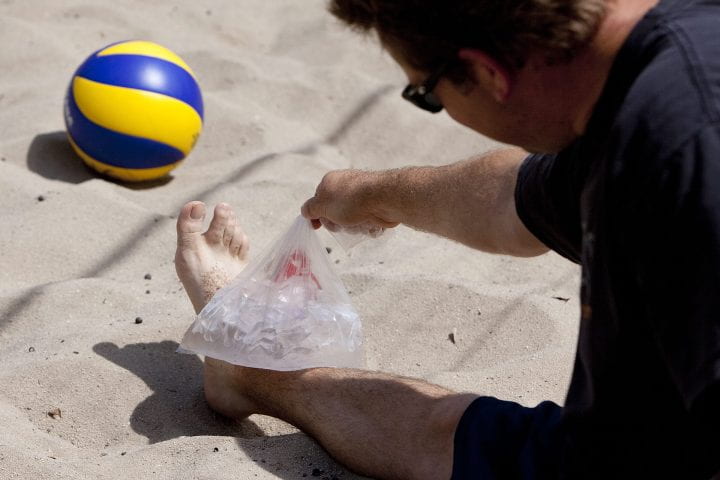Taming the weekend warrior
Dr. David Kruse, medical director of UC Irvine’s Orthopaedic & Sports Medicine Center, sees first-hand when weekend warriors push themselves a little too far. He offers his insights on avoiding injury while still having fun this summer.

Southern Californians are, by and large, active people. But every now and then, we overdo it, jumping headfirst into summertime sports we’re not prepared for — like pickup basketball, soccer, softball or beach volleyball, to name a few.
Dr. David Kruse, medical director of UC Irvine’s Orthopaedic & Sports Medicine Center, sees the all-too-often results: sprained ankles, stress fractures of the foot, Achilles tendon ruptures, knee ligament sprains, tendonitis flare-ups, hamstring tears, back strains and shoulder rotator cuff tendonitis. “The whole body is potentially at risk for injury, depending on what sport is being played,” he says.
To tame the weekend warrior within, Kruse advises aging adults to get smarter about their bodies and what activities they can handle. Here, he offers his insights on avoiding injury while still having fun this summer.
Q: What kind of injuries are older people more at-risk for?
A: As the body ages, many physiological changes happen. Differences in heart and lung function may affect the capacity to exercise; the best defense against this is to maintain a comprehensive exercise program throughout adulthood.
However, we also experience a decrease in muscle and bone mass; a reduction in the strength and flexibility of tendons and ligaments; and a decline in reaction time, coordination and joint stability. These physiological changes place the body at greater risk for injury.
Tendon and muscle tears are more frequent due to decreased tissue flexibility and increased muscle fatigue. In addition, there’s an age-related predisposition to arthritis, which could mean more joint pain with more activity.
Q: During the summer, do you see a rise in weekend warrior injuries?
A: Yes. Fortunately, we live in beautiful Southern California, which allows us to train and exercise year-round. Because of this, I see a fairly steady number of athletic injuries most months of the year, with a significant increase during the summer.
Weekend warriors tend to change their aerobic activity in the summer from indoor treadmills or elliptical machines to outdoor running. This puts a different strain on the feet and lower extremities, which can lead to pain syndromes or stress fractures.
Summer leagues for softball, soccer and basketball offer their share of ankle sprains, Achilles tendon ruptures and acute knee injuries. I also typically see more mishaps from such recreational activities as beach volleyball and surfing.
Q: Anything in particular you recall treating that illustrates these points?
A: One patient of mine was very motivated to lose weight during the summer and increase her activity for stress relief. She jumped right in with much enthusiasm and trained for a half marathon. Unfortunately, she didn’t properly build up her efforts, wore old shoes and didn’t do any cross-training.
Within four weeks, she developed a stress fracture in her foot. In the end, she had to limit her aerobic activity for many weeks because of this stress fracture, lost time and motivation, and never achieved her weight loss goals.
I also remember a beach volleyball athlete who sprained the medial collateral ligament in his knee. He didn’t initially seek appropriate treatment and didn’t complete his rehabilitation. Because of this, the recovery time escalated to three months instead of the routine three to four weeks, and he was unable to play in the whole volleyball league series.
Q: How can people avoid these types of injuries?
A: The stories above certainly don’t represent the majority of weekend warriors, but such things happen too often. The best way to avoid injury and prolonged recovery is to plan ahead, develop a reasonable training program and make sure to use updated equipment.
It’s crucial to include a session or two of cross-training to build and maintain a good base of strength, stability and flexibility. Don’t forget about proper nutrition and sleep – both are clearly factors in injury prevention. For the older athlete, maintaining a comprehensive exercise program is essential to combat some of the physiological changes I mentioned previously.
Some injuries, though, are unavoidable. When they happen, seek care early to obtain an accurate diagnosis and plan of care to achieve a safe and efficient return to your sport.
Q: Tendon and muscle injuries may not be life-threatening, but what kind of long-term issues can result from such slow-healing damage?
A: The key for these injuries is timely recognition and treatment. If they’re not addressed appropriately from the beginning, they can easily turn into chronic, slow-healing and frustrating injuries.
They can also very easily worsen or become a revolving door of recurrence. Get care for these injuries as soon as possible to ensure adequate rehabilitation and the confident resumption of activities.
Q: UCI’s Orthopaedic & Sports Medicine Center opened in Costa Mesa in 2010. What’s distinctive about it?
A: This satellite facility was established to give Orange County’s active population increased access to high-quality musculoskeletal and sports medicine care.
We provide expertise in sports medicine and orthopedic surgical subspecialties, such as those concerning the hands and other upper extremities, the spine, and the feet and ankles.
The OSMC offers same-day or next-day appointments — essential for athletes — and focuses on accurate diagnoses and treatment plans that facilitate a quick and safe return to sports.

